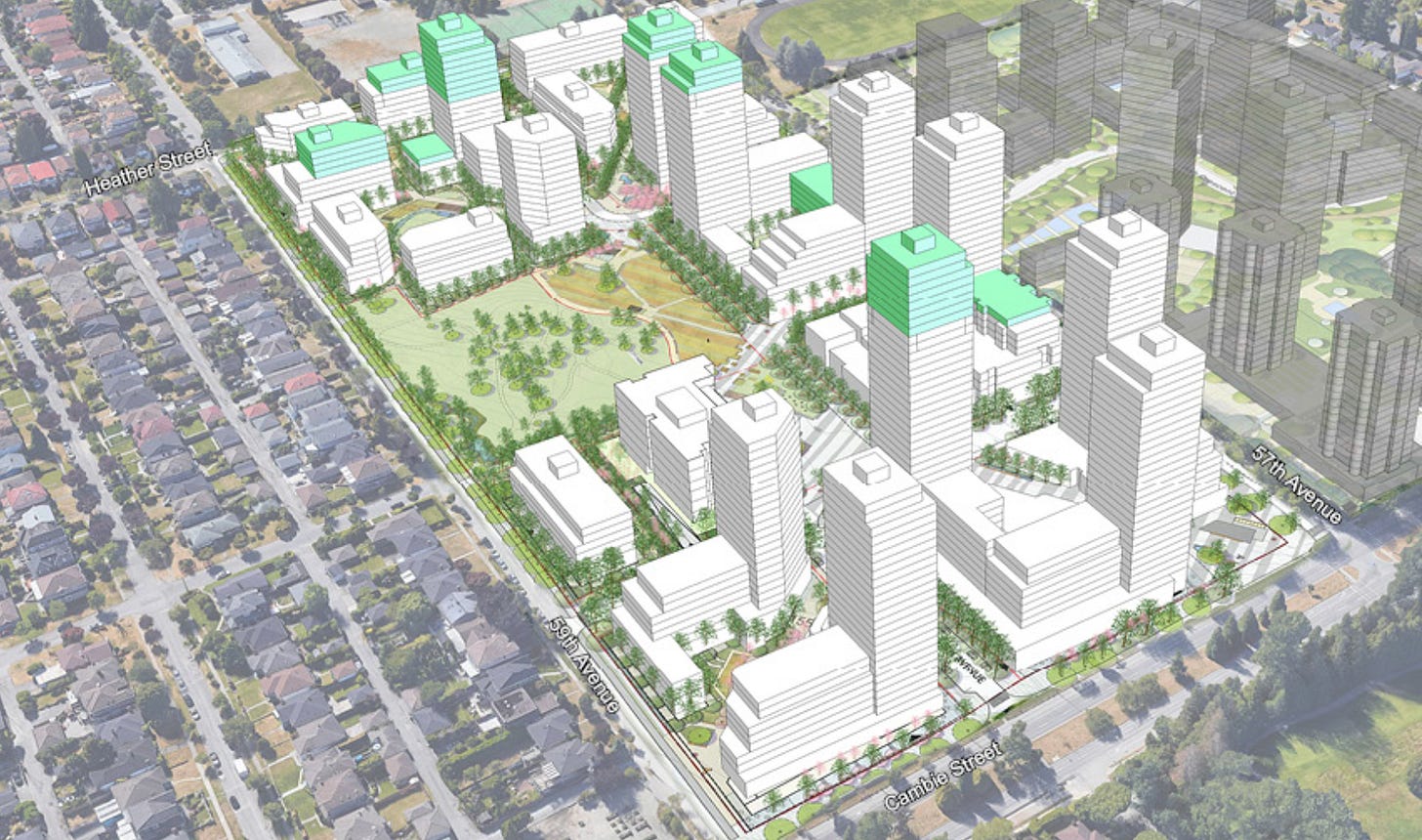“So what’s the rent?”
City Conversation #99: It seems to be more of a struggle than it should be to find out what is the “affordable” rent in a new Vancouver building.
January 31st 2022—Real life frustrations trying to figure out the true cost of rental housing.
The Pearson Dogwood site where Jane is looking for modest rental accommodation
“So what’s the rent?” Jane asked for the umpteenth time. This was her eighth email exchange on the subject over an eight day period.
Jane (not her real name to prevent her being blacklisted) has rented the same apartment for more than 20 years, but is about to be demovicted—that’s where a tenant is evicted because their apartment building is being demolished for redevelopment.
Now, the building Jane lives in is operated by a so-called “nonprofit” organization—except it’s demolishing her serviceable 35-year old building to replace it with more, smaller apartments for which future tenants will be charged much more rent for much smaller spaces. That appears to be okay with city staff as her home falls just outside the Broadway Plan boundaries that are supposed to provide a greater degree of renter protection and compensation.
Jane is single, working but not wealthy, so all of this matters. It just doesn’t seem to matter to her nonprofit landlord, nor to local and provincial governments. Not to her nonprofit landlord, which has been trying to get her and the remaining tenants out the door for well over a year (it’s cheaper for the landlord if they just leave), without incentives or other forms of assistance. Not to the city of Vancouver, which granted permission to redevelop without any substantive relocation assistance to existing tenants or assistance in finding comparable accommodation elsewhere. Not to the province, which just wants more housing—although it has recently offered $500 million of taxpayer money to allow nonprofits to buy existing buildings in the Broadway Plan area, even where, as in Jane’s case, they continue to demolish serviceable buildings they already own elsewhere in the city.
So Jane is looking for a new home to rent in Vancouver. Upon reading the recent announcement of the impending opening of what is billed as affordable rental housing at the Pearson Dogwood site at 57th & Cambie, she contacted the operating nonprofit (different from the one where she currently lives) with the questions on any renter’s mind: “What’s available? How big is it?” and most important: “What’s the rent?”
I’ve re-read the email string she shared with me several times now, with breaks between to deal with the resulting headache. My synopsis (edited for brevity):
(Nonprofit): there are more than 600 applicants ahead of you but you are welcome to apply.
(Jane): Thanks! For the low end of market (LEM) units, what are the rents for a 1-bed or 2-bed apartment?
(Nonprofit): Here are the market rent rates set by the city:
(Jane): How do High/Avg/Low relate to unit sizes, please?
(Nonprofit): Price depends on floor, unit square footage, patio size, view, etc. The unit sizes for one and two bedrooms vary as it depends on the floor plans. One-bedroom units range from 537 sq ft to 584 sq ft and two-bedrooms from 738 sq ft to 903 sq ft.
(Jane): Is the "lowest" rent in the table the (LEM) low-end-market rent?
(Nonprofit): Not quite. The price range, be it high, average, or low, is considered low-end of market (10% lower than average market in the region). The reasons there are higher and lower rent rates are because the rates depend on characteristics of the unit.
(Jane): And LEM rents are 10% less than this (with Housing Income Limits—HIL's), correct?
(Nonprofit): These prices are already 10% less than the average market rent in the region, as set out by the City of Vancouver. HILs represent the maximum gross household income for eligibility in many affordable housing programs. The HILs are based on figures established by CMHC and are intended to reflect the minimum income required to afford appropriate accommodation in the private market.
(Jane): I appreciate the responses and I’m hopeful you are not getting frustrated. When I look at the BC Housing HIL for 2023, it looks like the max gross household income, for a 3 bedroom for example, is $86,000. Your low end 3-bed rent x 12 months is $33,912 (we'll call it 34k). For the 3-bed LEM to be deemed "affordable", shouldn't the monthly rent not exceed 30% of the family’s gross income, which would be $26k, not $34k? These figures show that your LEM rent (with the maximum allowable income in accordance with BC Housing HILs) is 40% of the household income! This family (of at least 4) still needs to pay for hydro/cable/water/wifi/phone just for household basics. Not to mention food, clothing, transportation and school supplies (for example).
(Nonprofit): There are subsidized units and LEM units. Subsidized units use the 30% calculation and the HILS thresholds to determine eligibility. LEM rents are the rents I emailed earlier, there are also income eligibility requirements for these units, which are higher than what’s set for Rent Geared to Income (RGI) units. These rents are considered more affordable than the market rent in the area- the City of Vancouver set them to be 10% lower. LEM units do not use the 30% calculation but are set to be 10% less than average market rent for similar units in the region.
(Jane): Thanks for this. I'm sure you can understand that when the city of Vancouver rental market is grossly inflated and well above the household median income, "10% less the market" does not mean that the rents are affordable and if occupied, the rest of a person/family's life, livable.
I confirmed with Jane that she does not have a Masters in Economics or Business Administration. She just said, “That’s what renters in this city deal with all the time!”
This anecdote goes to a much bigger rental affordability issue. In the past four years the city has rezoned over 12,000 rental and social housing units in just over 100 projects, which is less than a quarter of all projects rezoned—the balance are strata. It’s unclear how many older rental homes were demolished to allow for the 12,000 new units. But only 3,500 of those rental/social homes have received building permits—I track this stuff—I have no idea how many have actually been completed, as the city does not integrate its development and building permit databases. Although the nonprofit noted above stated that occupancy of their first rental building was targeted for late 2022/early 2023, it does not appear on the city’s building permits database no matter how I enter the address data:
The city’s building permit database has “0 records” for the project Jane is interested in.
All by way of saying I can’t swear by all of my numbers, but my gut tells me they’re close. Interesting that one sixth of all of the rezoned rental homes that have (apparently) received building permits are at Pearson Dogwood—no wonder Jane focused her energies there!
I can’t help thinking that the morass of LEM, RGI, HIL, etc., is really just cover for the fact that that the city is approving way too little rental housing (just one quarter of the total in the past 4+ years, much of it by approving three times as much strata housing) and taking way too long to get it built. It takes an average of two years after a rezoning is approved until the first building permit is issued for a project, so the province’s solution, eliminating public hearings, doesn’t cut it. The red tape that needs cutting is at city halls, not with the citizens who vote them in, and can vote them out.
Today’s questions: Are you a renter? If so, where and for how long (or how much longer)?
I read and respond to all comments. If you enjoyed this post, consider becoming a free subscriber to City Conversations at
Brian Palmquist is a Vancouver-based architect, building envelope and building code consultant and LEED Accredited Professional (the first green building system). He is semi-retired for the moment, still teaching and writing, so not beholden to any client or city hall. These conversations mix real discussion with research and observations based on a 40+ year career including the planning, design and construction of almost every type and scale of project. He is the author of the Amazon best seller “An Architect’s Guide to Construction.” and working on a book about how we can accommodate a growing population while saving the Vancouver we love.








Few points;
- suggest that City tie Development and Building permit together for rental projects, as they do for small projects, add a large refundable deposit that is relinquished if the project does not break ground within 1 year from approval and continues without interruption.
- the rental rates that are supposed to be 10% below market are actually market or above if the take rents per sf in older buildings.
- ask what buildings are surveyed for market rents? One would get vastly different data from different locations, and different ages and conditions. Was the survey taken from only new projects?